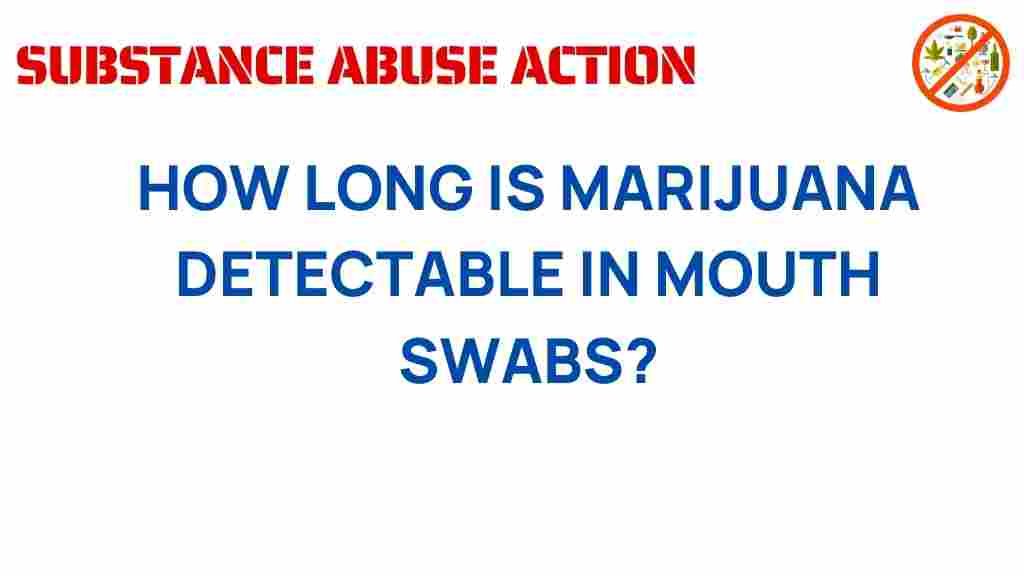The Hidden Timeline: How Long is Marijuana Detectable in Mouth Swabs?
As cannabis legalization spreads across various regions, the conversation surrounding marijuana detection has intensified, particularly concerning drug testing methods. One of the most common and non-invasive methods is saliva testing, often referred to as mouth swabs. This article delves into the detection window of THC in saliva, the implications of marijuana detection through mouth swabs, and health risks associated with substance use. Understanding these aspects is crucial for anyone who uses cannabis or is subject to drug testing.
Understanding Saliva Tests for Marijuana Detection
Saliva tests are increasingly being used for marijuana detection due to their convenience and quick results. They are favored in workplaces, law enforcement, and rehabilitation settings. Saliva tests primarily detect the active ingredient in cannabis: THC (tetrahydrocannabinol).
- Non-invasive: Saliva tests require only a sample of saliva, making them less intrusive than urine or blood tests.
- Fast results: Saliva tests can provide results within minutes, allowing for immediate decision-making.
- Portable: Many saliva testing kits are compact and easy to use in various settings.
How THC is Detected in Saliva
When cannabis is consumed, THC enters the bloodstream and can be detected in various bodily fluids, including saliva. The detection window for THC in saliva varies based on several factors:
- Frequency of use: Regular users may retain THC in their system longer than occasional users.
- Dosage: Higher doses of cannabis can lead to longer detection times.
- Metabolism: Individual metabolic rates can affect how quickly THC is eliminated from the body.
The Detection Window of THC in Mouth Swabs
Understanding the detection window is crucial for those concerned about drug testing. The detection window refers to the period during which THC can be identified in saliva following consumption. Here’s a detailed overview:
1. Occasional Users
For individuals who use cannabis infrequently (1-2 times per month), THC can typically be detected in saliva for:
- Up to 24 hours after use.
2. Moderate Users
Those who consume cannabis several times a week may find THC detectable for:
- 1 to 3 days after last use.
3. Heavy Users
Regular users who consume cannabis daily may have THC detectable in their saliva for:
- Up to 7 days or more.
Factors Influencing Detection Times
Several factors can influence how long THC remains detectable in saliva:
- Hydration levels: Well-hydrated individuals may clear THC from their system more quickly.
- Oral hygiene: Poor oral care can prolong the presence of THC in saliva.
- Body fat percentage: THC is stored in fat cells; those with higher body fat may retain THC longer.
Legal Implications of Marijuana Detection via Saliva Tests
With the legalization of cannabis in many areas, the legal implications surrounding marijuana detection are complex. Here are some critical points to consider:
1. Workplace Policies
Employers may have strict drug testing policies that include saliva testing for THC. It is essential for employees to understand their rights and the company’s policies regarding marijuana detection.
2. Driving Under the Influence
In many jurisdictions, driving under the influence of cannabis is treated similarly to alcohol. A positive saliva test for THC can lead to legal consequences, including fines, license suspension, and even jail time.
3. Rehabilitation and Probation
Individuals in rehabilitation programs or on probation may be subject to random saliva testing. A positive result can have significant ramifications, including extended rehabilitation or legal penalties.
Health Risks Related to Substance Use
While marijuana is often viewed as a safer alternative to other substances, it carries health risks, especially when used heavily. Here are some potential health concerns:
1. Impaired Cognitive Function
THC can impair cognitive abilities, affecting memory, attention, and decision-making skills. This impairment can have significant consequences in everyday life, especially in high-stakes situations like driving.
2. Respiratory Issues
For those who smoke cannabis, there are potential respiratory risks, including chronic bronchitis and other lung-related issues. These risks can escalate with frequent use.
3. Dependency and Withdrawal
Some users may develop a dependency on cannabis, leading to withdrawal symptoms when they stop using. These symptoms can include irritability, insomnia, and appetite changes.
Troubleshooting Tips for Saliva Tests
For those who may be concerned about upcoming saliva tests, here are some troubleshooting tips:
1. Stay Hydrated
Drinking plenty of water can help flush toxins from your system, although it is not a guaranteed method for passing a saliva test.
2. Maintain Good Oral Hygiene
Brushing your teeth, using mouthwash, and chewing gum can help reduce the concentration of THC in saliva temporarily.
3. Avoid Cannabis Use Before a Test
The most effective way to ensure a negative test result is to abstain from using cannabis before the scheduled test date.
4. Know Your Rights
Understanding your rights regarding drug testing can help you navigate any potential issues that arise. Familiarize yourself with local laws and workplace policies.
Conclusion
In conclusion, understanding the nuances of marijuana detection, particularly through mouth swabs, is essential for individuals who use cannabis. The detection window for THC in saliva can vary significantly based on usage frequency, individual metabolism, and other factors. Legal implications and health risks associated with substance use further complicate the landscape, making it imperative for users to stay informed and prepared. By following the tips outlined in this article, individuals can make better decisions regarding cannabis use and drug testing.
For more information on drug testing policies, visit this resource.
If you want to learn more about cannabis use and its effects, check out this guide.
This article is in the category Health and created by SubstanceAbuseAction Team
